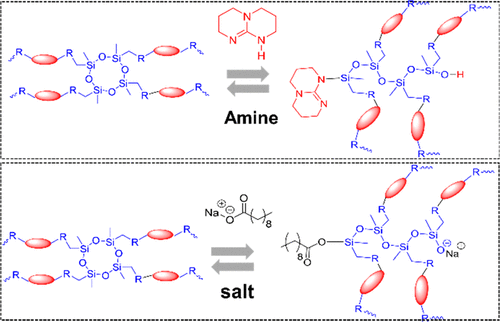当前位置:
X-MOL 学术
›
ACS Macro Lett.
›
论文详情
Our official English website, www.x-mol.net, welcomes your
feedback! (Note: you will need to create a separate account there.)
Catalytic Control of Plastic Flow in Siloxane-Based Liquid Crystalline Elastomer Networks
ACS Macro Letters ( IF 5.1 ) Pub Date : 2020-05-06 , DOI: 10.1021/acsmacrolett.0c00265 Mohand O Saed 1 , Eugene M Terentjev 1
ACS Macro Letters ( IF 5.1 ) Pub Date : 2020-05-06 , DOI: 10.1021/acsmacrolett.0c00265 Mohand O Saed 1 , Eugene M Terentjev 1
Affiliation

|
Liquid crystalline elastomer networks cross-linked by dynamic covalent bonds (xLCE) have the ability to be (re)processed during the plastic flow. However, the current bond-exchange strategies that are used to induce plastic flow in xLCE lack the efficient method to control the elastic-plastic transition. Here we describe a straightforward method to manipulate the transition to plastic flow via the choice of catalyst in xLCE cross-linked by siloxane. The nature and the amount of catalyst have a profound effect on the elastic–plastic transition temperature, and the stress relaxation behavior of the network. The temperature of fast plastic flow and the associated bond-exchange activation energy varied from 120 °C and 83 kJ/mol in the “fastest” exchange promoted by triazobicyclodecene (TBD) to 240 °C and 164 kJ/mol in the “slowest” exchange with triphenylphosphine (PPH), with a range of catalysts in between. We have identified the optimum conditions for programming an aligned monodomain xLCE, high programming temperature (230 °C) and low nematic to isotropic transition (60 °C), to achieve thermally and mechanically stable actuators.
中文翻译:

硅氧烷基液晶弹性体网络中塑性流动的催化控制
通过动态共价键 (xLCE) 交联的液晶弹性体网络能够在塑料流动过程中进行(重新)加工。然而,目前用于在 xLCE 中诱导塑性流动的键交换策略缺乏控制弹塑性转变的有效方法。在这里,我们描述了一种通过选择由硅氧烷交联的 xLCE 中的催化剂来控制向塑性流动转变的简单方法。催化剂的性质和用量对弹塑性转变温度和网络的应力松弛行为有深远的影响。快速塑性流动的温度和相关的键交换活化能从三唑二环癸烯 (TBD) 促进的“最快”交换中的 120 °C 和 83 kJ/mol 变化到“最慢”交换中的 240 °C 和 164 kJ/mol与三苯膦 (PPH) 交换,中间有一系列催化剂。我们已经确定了编程对齐的单畴 xLCE、高编程温度 (230°C) 和低向列向各向同性转变 (60°C) 的最佳条件,以实现热和机械稳定的致动器。
更新日期:2020-05-06
中文翻译:

硅氧烷基液晶弹性体网络中塑性流动的催化控制
通过动态共价键 (xLCE) 交联的液晶弹性体网络能够在塑料流动过程中进行(重新)加工。然而,目前用于在 xLCE 中诱导塑性流动的键交换策略缺乏控制弹塑性转变的有效方法。在这里,我们描述了一种通过选择由硅氧烷交联的 xLCE 中的催化剂来控制向塑性流动转变的简单方法。催化剂的性质和用量对弹塑性转变温度和网络的应力松弛行为有深远的影响。快速塑性流动的温度和相关的键交换活化能从三唑二环癸烯 (TBD) 促进的“最快”交换中的 120 °C 和 83 kJ/mol 变化到“最慢”交换中的 240 °C 和 164 kJ/mol与三苯膦 (PPH) 交换,中间有一系列催化剂。我们已经确定了编程对齐的单畴 xLCE、高编程温度 (230°C) 和低向列向各向同性转变 (60°C) 的最佳条件,以实现热和机械稳定的致动器。











































 京公网安备 11010802027423号
京公网安备 11010802027423号